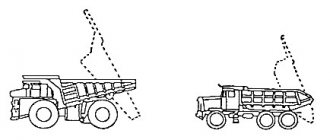Classification of loads by displacement model
According to the mechanical model of displacement, all types of displacement loads are classified as follows:
- absolutely solid body (containers, roll-trailers, large-sized and other so-called cargo items);
- continuous cohesive granular medium (bulk and grain);
- discrete structure (packages, rolled metal, pig iron, scrap metal, etc.).
Loads, namely: mobile equipment, railway cars, containers, platforms, removable tanks, close to the state of an absolutely solid body, are on the ship under the influence of forces that do not depend on the properties of the cargo itself.
Loading of moving cargo onto a ship Source: Pixabay.com
Depending on the fastening system used, such loads are divided into:
- standardized cargo - cargo for which the ship is intended, and which is secured using an approved system of special devices corresponding to the type of cargo items (containers on container ships, wagons on railway ferries, etc.);
- semi-standardized cargo - cargo for which the ship is intended, and which is secured using devices used for securing a limited range of types of cargo items (cars, roll-trailers, etc.).
Cargoes, consisting of individual more or less large and homogeneous particles (grain and bulk), form a continuous cohesive granular medium with constant or naturally and continuously changing physical and mechanical properties. The displacement conditions in such an environment depend on the strength properties of the load, determined using special methods.
Non-standardized cargo is cargo that requires an individual approach each time to be stowed and secured. Such cargoes are divided into two groups:
- cargo spaces;
- structure-forming loads.
Cargo packages are cargo, the placement and securing of which is carried out individually by connecting each cargo package to the structures of the ship's hull.
Loading equipment or any of its components that are transported on a ship (ship tractors, loaders, etc.), but are not permanently attached to it, should also be considered as cargo items.
All other non-standardized cargoes are structure-forming, i.e., when they are stowed on a ship, they form discrete (composed of individual elements) structures - arrays (stacks), the properties of which depend not only on the characteristics of individual cargo items, but also on the order and direction , the method of their installation. The same load, laid in different ways, forms structures that have different properties, including different resistance to displacement in different directions under the influence of external forces.
Stability limitations
Finally, the so-called limitations on ship stability. They are related to the correct distribution of weight on board the vessel. Compliance with such restrictions ensures that containers are positioned on board in the safest possible manner. Taking into account these limitations helps to find the optimal way to place containers for proper weight distribution already at the initial stages.
The vessel must be loaded so that it can navigate in all weather conditions. Consequently, containers are loaded in such a way as to avoid loss of stability, sagging or twisting of the vessel. This may disrupt navigation. It is also desirable that stability restrictions be respected at transit ports. Loss of stability can lead to imbalance during unloading.
Placing cargo on the vessel
Cargo on the ship must be placed based on the following conditions:
- rational use of the cargo capacity of the premises and the carrying capacity of the vessel;
- compatibility and safety of cargo during transportation;
- maintaining the local and overall strength of the vessel;
- ensuring the necessary landing and stability throughout the voyage;
- providing a view of the sea surface from the ship's control position;
- ensuring that the load does not move under the influence of pitching;
- the possibility of using shore reloading facilities and unhindered unloading and loading at intermediate ports of call.
Placing cargo on the ship Source: Pixabay.com
The following cargoes are prohibited from being transported together in one cargo space:
- polluting, dusty and afraid of pollution;
- those that release moisture, for example, during evaporation, and are afraid of getting wet or damp;
- emitting odors and perceiving them;
- emitting toxic gases and food products;
- carriers of quarantine objects and those exposed to them;
- requiring various heat and moisture ventilation modes during transportation.
Compliance with local strength, specified in ship documentation in the form of permissible specific load on the floor, can be determined:
and the maximum permissible height of the cargo stack according to the formula:
H = μ q,
Where:
- H – height of cargo stack, m;
- q – permissible load on the floor, tf/m2;
- μ – specific loading volume (SLV) of a specific type of cargo, m3/t;
b the maximum permissible number of tiers i when stacking cargo according to the formula:
i = PERMISSIBLE CROSS LOADS, q, t s/m 2 DISTRIBUTION n a l load o f one cargo space, q, m s / m 2
Regardless of the ship's draft, trim and deck cargo, the view of the sea surface from the ship's control position should not be obscured at a distance of more than two ship lengths or 500 m, whichever is less, forward of the bow up to 10 degrees. on each side.
No shadow created by cargo located forward outside the wheelhouse, obstructing the view of the sea surface from the ship's control position, should not exceed 10 degrees. The total shadow sector should not exceed 20 degrees. Sectors of unobstructed view between shadow sectors should not be less than 5 degrees. However, with the review described in the previous paragraph, each individual shadow sector should not exceed 5 degrees.
The placement of cargo on the ship is determined by the cargo plan, drawn up in two stages:
- before loading the vessel, a preliminary cargo plan is drawn up;
- during loading - executive cargo plan.
The preliminary cargo plan is drawn up by the organization loading the cargo. Taking into account the requirements for stowing and securing the cargo, it is approved by the captain of the vessel before loading.
When transporting homogeneous cargo, a preliminary cargo plan is drawn up jointly by the ship's administration and a representative of the organization performing the loading.
Stowing and securing cargo
Cargo accepted on board the ship must be properly stowed and secured to prevent it from shifting during sea transportation.
Stowage and securing of cargo are carried out in accordance with the requirements of the ship's manual for securing cargo, information about the cargo and taking into account the following factors:
- flight duration;
- geographical area of navigation;
- expected sea state;
- size, type and characteristics of the vessel;
- static and dynamic forces expected during the voyage;
- type and packaging of cargo packages;
- the planned order of placement of cargo packages;
- weight and overall dimensions of cargo packages;
- applied calculation methods and the limitations and conditions inherent in them.
Securing of standardized and semi-standardized cargo is carried out on the basis of instructions for securing cargo and ship operational documentation, approved in the prescribed manner.
If the ship's documentation does not contain the necessary data, the cargo is secured in accordance with the requirements of information about the cargo and regulatory technical acts. Also according to methodological documents for the safety of maritime transportation of specific goods, approved in the prescribed manner.
Placement and securing of non-standardized cargo - large and heavy cargo - is carried out according to individual projects developed by shippers. In the methods of stowing and securing non-standardized structure-forming cargo, given in the instructions for securing cargo and in information about the cargo, it is necessary to take into account the shape, size and strength of the cargo packages. These indicators must be used to create a stable stack structure that can withstand, without collapsing, the static and dynamic loads expected during the upcoming sea transportation.
Securing cargo to the deck of a ship Source: Pixabay.com
In cargo spaces of awkward shape, strong barriers, cages and other structures must be installed to ensure the density and stability of the stack. Wooden boards, beams, wedges, etc. can serve as materials for structures.
The immovability of a stable stack is ensured by securing its surface. The surface of the stack can be secured:
- by densely packing a stable load over the entire surface of the stack in the cargo area;
- by additional loading of another tightly packed and securely secured load, the mass of which must be no less than the mass of the surface tier of the secured stack; before additional loading, the surface of the stack must be lined with a sufficient number of boards with a thickness of at least 15 mm; The total permissible amount of cargo in a stack is determined by the formula:
Q = l B qr
Where:
- l – stack length, m;
- B – width of the cargo space, m;
- qi – permissible load on the floor, t/m2;
- one of the methods given in regulatory technical acts, as well as in methodological documents on the safety of maritime transportation of relevant types of cargo;
- other methods recommended in the prescribed manner.
Before loading cargo that is not in the ship's securing instructions, the captain must use the information about the cargo provided by the shipper. In the absence of such information about the cargo, the captain has the right to refuse to accept the cargo for transportation. If there are no conditions on board the vessel for stowing and securing the cargo to ensure that it does not move during the voyage, the captain has the right to refuse to accept the cargo for transportation.
Suggested reading: Regimes for transporting vegetables and fruits by sea
If there are no conditions on board the vessel for stowing and securing the cargo to ensure that it does not move during the voyage (sufficient materials and means of fastening, etc.), the captain has the right to refuse to accept the cargo for transportation.
The fastening system used must not cause any damage to the cargo. The lashings must not touch the wheel tires or any other easily damaged areas of the load. If it is necessary for the lashings to touch sharp protruding parts of the load or places that can be damaged by them, wooden or other spacers should be installed.
Spherical and cylindrical loads, unpackaged equipment. Metal structures, as well as loads that do not have special eyes and butts, are recommended to be secured with girth lashings (belts).
Mobile equipment must be secured to tow hooks, holes, lugs and brackets specifically designed for this purpose, as well as to the frame, chassis and other parts rigidly connected to the frame of the machine, provided that the securing system will not cause damage to these parts.
When installing cargo Rules for the maritime transportation of dangerous goods with a complex shape of the supporting surface, special foundations or saddles should be used. The design of fastening large-sized and heavy cargo may include the installation of cages, keel blocks and other devices developed as part of an individual project.
The actual placement of cargo on the ship, taking into account possible changes that arise during the loading process, is reflected in the executive cargo plan, which is drawn up by the organization performing the loading.
Loss of cargo due to damaged fastenings Source: Pixabay.com
The captain of the vessel ensures that the stowage and securing of cargo meets the requirements of the cargo securing manual and cargo information.
Additional securing of cargo at the request of the captain in excess of that specified in the information about the cargo and/or in the instructions for securing cargo is carried out at the request of the vessel.
It is not permitted for a vessel to depart on a voyage with unsecured cargo. The time of completion of cargo securing work and the section (item) of the ship's cargo securing manual, in accordance with which this work was carried out, must be recorded in the ship's log.
Forms of organization of transportation and fleet operation
The form of transportation organization is largely determined by the company's cargo base. The cargo base is cargo flows determined by contractual obligations. Types of contractual obligations:
- government orders are, as a rule, Arctic transportation and transportation related to government relations;
- export-import transportation at the request of specific cargo owners;
- transportation of bulk and general cargo on the basis of a freight contract.
Features of cargo flow:
- direction of cargo flow by geographical points;
- volume of cargo traffic, i.e. number of tons;
- balance of cargo flow (balance);
- uniformity of cargo presentation across months and quarters (if there is uniformity of cargo presentation, then such cargo flow is stable);
- seasonality (frequency) of cargo flow (seasonal cargo flow is associated with the transportation of agricultural products, periodic – with weather conditions).
Structurally, cargo flows are divided:
- by type of cargo (liquid, bulk, sea transportation of general cargo; general cargo);
- by the size of sales contracts, among which are: freight contract (general contract, usually concluded for the transportation of homogeneous bulk cargo of large volume. Transportation, as a rule, is carried out all year round);
- voyage charter - transportation, according to the size of the ship lot (lot providing either full carrying capacity or full cargo capacity);
- episodic contracts;
- using cargo consolidation means;
Cargo flows shape the composition and tonnage of the fleet, the features and specialization of ports, and determine the form of organization of the fleet.
Forms of organizing the work of the fleet are divided into regular and irregular.
Regular - liner transportation and fleet operation in successive flights.
Irregular - episodic, “tramp” transportation.
Main signs of regularity:
- constant direction of transportation;
- securing a certain tonnage in a given direction;
- operation of vessels according to a pre-established traffic pattern;
- compliance with a certain movement mode with specified accuracy.
Regular forms of organizing transportation and vessel traffic have the following features:
- stable income;
- simplified operational planning;
- reduced level of ballast runs;
- cargo specialization of ships;
- efficient cargo handling of ships;
- captains' knowledge of the peculiarities of port operation;
- increased security;
- low cost ratio;
- the rhythm of the fleet's work.
The organization of the fleet's work in successive flights is carried out on a powerful cargo flow of homogeneous (bulk) cargo. The carrier usually serves one cargo owner. A freight (general) contract is concluded between the carrier and the cargo owner, which specifies:
- traffic volume;
- transportation period;
- loading/unloading ports;
- ship party;
- regularity of shipments;
- freight rate;
- pro forma charter.
Based on these conditions, a schedule for delivering vessels for loading is drawn up. The carrier allocates a certain number of vessels to ensure cargo flow.
Ensuring the safety of the vessel and the safety of cargo during the voyage
During a voyage, it is necessary to regularly monitor stability during the rolling period of the vessel. A sharp increase in the rolling period indicates a significant decrease in the stability of the vessel.
It is also necessary to regularly receive reports and forecasts of weather and sea conditions in order to prevent the vessel from entering an area with waves exceeding those taken into account when calculating cargo securing.
A cargo ship enters a rough area Source: Pixabay.com
If it is impossible to avoid such waves, it is necessary to take all measures to seal the ship's hull and, if necessary, check the securing of cargo in compliance with safety measures. Measures to ensure the safety of the ship when sailing in a storm. Descent into the cargo space should be permitted only after checking that there are no toxic or harmful factors in the cargo space that pose a danger to life and health.
When checking the condition of cargo, you must pay attention to:
- displacement of loads;
- weakening of fastening systems;
- loosening of container structures and their deformation;
- the possibility of dynamic contacts of cargo packages with each other and with hull structures;
- redistribution of loads arising as a result of the shutdown of fastening parts, gaskets and having an adverse effect on the strength of the structure of the vessel, cargo and its fastening;
- cargo damage;
- sweating of cargo and ship structures;
- other conditions and circumstances that may have an adverse effect on the condition of the cargo and its quality.
If deficiencies are found, measures should be taken to eliminate them and, if necessary, additional fastening of the loads should be made (tightening the lashings, tamping and fixing the wedges with nails, installing additional gaskets, etc.). The results of checking the condition of cargo must be recorded in the ship's log.
Measures to prevent loss of buoyancy, vessel stability and displacement of cargo:
- in stormy conditions, all entrances and other openings through which water can penetrate into the hull or superstructure, deckhouse, etc. must be closed;
- side windows must be kept in good condition; in stormy conditions they must be securely closed;
- scuppers must be cleaned and in working order;
- the number of partially filled tanks on board should be kept to a minimum;
- do not start ballasting without making calculations of stability and the influence of the received ballast on it;
- tanks, except for consumables, in which there are free surfaces, if possible, should be pressed in before ballasting begins;
- take ballast into only one tank or one pair of tanks at a time, if taking it into one will cause a noticeable list;
- you need to start ballasting by filling the tank, the free surface of which will give the smallest correction to the metacentric height (as a rule, end tanks);
- rectangular tanks in the middle part of the hull are usually filled last;
- ballast must be received as quickly as possible;
- when taking ballast into any tank, do not stop this operation until it is completely pressed in; the next tank should be filled after the previous one is completely pressed in;
- other necessary measures.
The consequence of loss of buoyancy is displacement of the load Source: Pixabay.com
If a list occurs, the dynamic loads on the vessel should be immediately reduced, for which:
- reduce the speed of the vessel;
- bring the ship's bow against the wave; however, if the vessel’s stability is insufficient, this measure should be used extremely carefully, since turning even in calm water can cause additional roll of the vessel;
- in the event of a constant heel, it is necessary to verify by means of control pumping from bilges and bottom tanks that the cause of the heel is displacement of the load;
- if possible, taking appropriate precautions, taking ballast to increase stability and follow the shortest safe course to exit the storm zone;
- completely eliminating the list by taking ballast is allowed only after the ship leaves the storm zone.





